Angela Detanico och Rafael Lain
Artist duo Detanico and Lain’s work is focused on language, specifically typography. New Roman Times (2011) is a remodelling and reversal of the classic typeface Times New Roman. SATOR AREPO TENET OPERA ROTAS (2011) is an adaption of a mysterious Latin palindrome, which can be written in a square and read from all directions. Detanico and Lain have created their own coded alphabet and written the palindrome with concrete slabs on the floor.
Angela Detanico (1974) and Rafael Lain (1973) are an artist duo from Brazil. They live and work in Paris, France. Selected recent exhibitions include Galería Moro, Santiago, Chile (2010); Jeu de Paume, Paris, France (2008); Museu de Arte da Pampulha, Belo Horizonte, Brazil (2008).
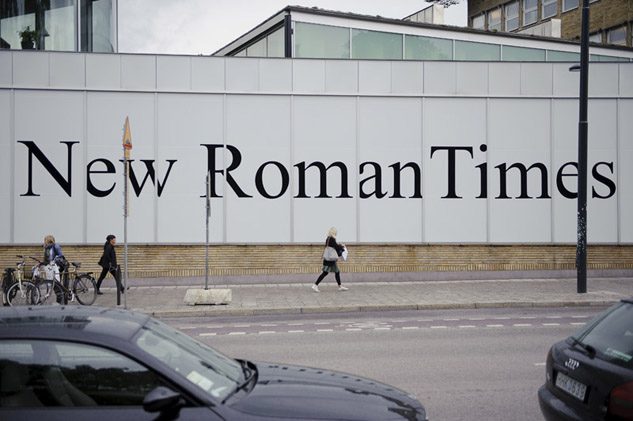
Maurício Dias och Walter Riedweg
In Juksa (2006), Maurício Dias and Walter Riedweg capture a meeting with the few remaining inhabitants of the Sørfugløya island off the coast of northern Norway. Their interviews are interspersed with an old black-and-white documentary about the inhabitants of the island, made several decades ago for Norwegian television. Together, the films relate the history of Sørfugløya.
Maurício Dias was born in 1964 in Rio de Janeiro, Brazil, and Walter Riedweg in 1955 in Lucerne, Switzerland. They have worked together since 2003. Juksa was first shown at the 2006 Lofoten International Arts Festival in Norway. Selected exhibitions include Dias & Riedweg, Americas Society, New York, USA (2009); Documenta 12, Kassel, Germany (2007); Dias & Riedweg, MACBA, Museum of Contemporary Art Barcelona, Spain (2003); 48th Venice Biennial (1999); São Paulo Biennial (1998, 2000 and 2002).
Eugenio Dittborn
Since 1984 Eugenio Dittborn has created works he calls Airmail Paintings – collages constructed out of photocopies and other cheap, simple materials which he stitches onto fabric. The works are folded into special envelopes, which are sent from place to place by regular post – in the 1980s this was a powerful comment on Chile’s totalitarian regime that restricted travelling. Over the course of a journey, the works gather new meaning, much like souvenirs. The exhibition will include the works The Internment of Malevitch II (Airmail Painting No. 116, 1995–1998) and The 26th History of the Human Face (Miti Mota)(Airmail Painting No. 149, 2002–2003).
Eugenio Dittborn was born in 1943 in Santiago, Chile, where he lives and works. Initially working under the isolation of the military dictatorship in Chile, Dittborn found in his Airmail Paintings a way to bypass the bureaucratic system and engage in the activities of the international art world by sending his items to galleries around the world. His first large retrospective at Witte de With, Rotterdam, Holland, in 1993 presented more than 80 Airmail Paintings from the past decade. His work has also been shown in a large number of group exhibitions, including the IV Biennial de la Habana, Havana, Cuba (1991); The New Museum for Contemporary Art, New York, USA (1991); Dokumenta 9, Kassel, Germany (1992); The Museum of Contemporary Art, Sydney, Australia (1993). His work is included in numerous museum collections, such as the Tate in London, UK, and Moderna Museet in Stockholm.
Öyvind Fahlström
Öyvind Fahlström was an artist, poet, playwright and composer. He was immensely productive and one of the front figures of 20th-century Swedish experimental art. Born in 1928 in São Paulo, Brazil, Fahlström had a Norwegian father and a Swedish mother. In 1939, the then 10-year-old Fahlström came alone to Sweden to visit his relatives. When Germany invaded Poland in September the same year and World War II began, it was impossible for him to return back home. Later in life he lived in New York, Paris and Rome but never returned to Brazil.
Dominique Gonzalez-Foerster
Dominique Gonzalez-Foerster’s Textorama (2011) has its basis in an exhibition she produced for the Hispanic Society of America in 2009–2010. Her exhibition related to the institution’s famous research library. The calligrammatic wall is an exploration and continuation of this library, with excerpts and quotations from canonical as well as unknown works of various languages.
Dominique Gonzalez-Foerster was born in 1965 in Strasbourg, France. She lives and works in Paris, France, and Rio de Janeiro, Brazil. Her recent solo exhibitions include Centre Georges Pompidou, Paris (2002); Tate Modern, London, UK (2008); Kunsthalle Zürich, Switzerland (2004).
Cao Guimarães
Cao Guimarães’ feature film Ex Isto (Ex It)(2010) is inspired by the hypothesis in Paulo Leminski’s experimental novel Catatau from 1975: What would have happened if René Descartes had gone with the Dutchman Maurice of Nassau to Brazil in the 1600s? We follow the philosopher on a breath-taking and exotic journey, full of discoveries, hallucinogenic herbs and finally a confrontation with his own doubts.
Cao Guimarães was born in 1965 in Belo Horizonte, Brazil, where he lives and works. His work is part of the collection at Tate Modern in London, UK, MoMa and Guggenhein in New York, USA, and Fondacion Cartier in Paris, France. He has participated in the 25th and 27th International São Paulo Biennials, Cannes Film Festival (2005), Sundance Film Festival (2007) and Rio International Film Festival (2001, 2004, 2005, 2006).
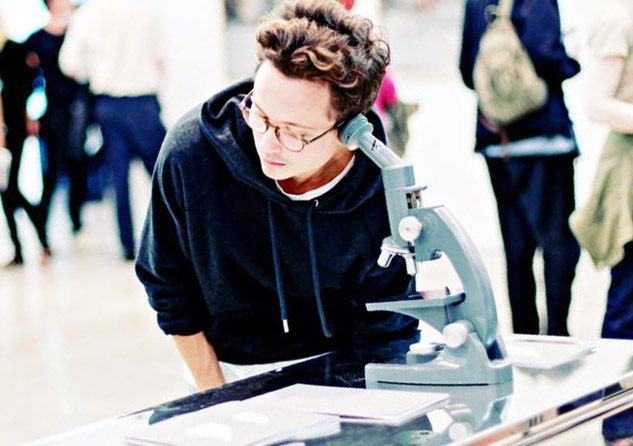
Laura Lima
In Laura Lima’s work, the human body is not separated from other materials. This is evident in Marra (1996 and 2011), which is part of Lima’s series MAN=flesh/WOMAN=flesh. In Marra, two naked men wrestle in the exhibition space. They are conjoined by a hood that both renders them anonymous and blinds them. Her work is concerned with the bodies and the struggle, or collaboration, between them.
Laura Lima was born in 1971 in Governador Valadares, Brazil. She lives and works in Rio de Janeiro. Selected exhibitions include 11 Rooms at Manchester Art Gallery, Manchester, UK (2011); 11th Lyon Biennale, Lyon, France (2011); La Centrale, Montreal, Canada (2010); Grande at Casa França Brasil, Rio de Janeiro (2010); Scape at A Gentil Carioca, Rio de Janeiro (2008); 24th and 27th São Paulo Biennials.
Arto Lindsay
For an hour during the opening of The Spiral and the Square, Arto Lindsay and his band transform the exhibition room into a concert hall/club.
Melvin Gibbs – bass
Juninho Costa – guitar
Marivaldo Paim – percussion
Guillermo Brown – drums
Arto Lindsay is a multi-faceted musician who has spent decades crossing geographical and musical boundaries. Much of his inspiration comes from Brazilian music and art, since he has long been active both as an artist and a curator.
Arto Lindsay was born in 1953 in Richmond, Virginia. He lives and works in Rio de Janeiro, Brazil.

Dora Longo Bahia
AcordaLice/wAkupaLice (2006) refers to and mixes Lewis Carroll’s Alice in Wonderland with James Joyce’s Finnegans Wake and Ulysses. The installation, comprising film, sound and text, invites the visitor into a mysterious and peculiar world with undefined boundaries between fiction and the real world.
Dora Longo Bahia was born in 1961 in São Paulo, Brazil, where she lives and works. Her recent solo exhibitions include Trash Metal at Galeria Vermelho, São Paulo (2010) and Escalpo carioca e outras canções at Centro Cultural Banco do Brasil, Rio de Janeiro (2006).
Renata Lucas
In Plan de evasión (Escape plan), Renata Lucas has taken unbound copies of Argentinian author Adolfo Bioy Casares’ novel of the same title, and sewn the pages into a selection of books in Bonniers Konsthall’s bookshop. By just looking at the covers, the intervention is invisible, making it impossible to know beforehand which books have been altered.
Renata Lucas was born in 1971 in Ribeirão Preto, Brazil, and lives and works in São Paulo. Her work has been exhibited at, among others, Tate Modern, London, UK (2007), the Sydney Biennial (2008), the 53rd Venice Biennale (2009) and the KW Institute for Contemporary Art, Berlin, Germany (2010).
Cinthia Marcelle
Through films, installations, photographs and performances, Cinthia Marcelle plays around with perspectives in order to create geometric patterns in everyday situations. One example of this is her video work Ao Plano (2010–2011), where four lorries repeatedly attempt to park in a square, and the camera’s bird’s-eye perspective allows us to view the event in a completely different way than we would from ground level.
Cinthia Marcelle was born in 1974 in Belo Horizonte, Brazil, where she lives and works. Selected exhibitions include 9th Lyon Biennial (2007) and 29th São Paulo Biennial (2009).
Rodrigo Matheus
Rodrigo Matheus’ works explore representation and perception in art and nature. In Nature of Construction (2011) a metal net installed between the branches of a tree. This type of net is generally placed over windows in Brazil in order to stop children from falling out. The Landscape is a kind of diorama in which a landscape painting hung in the background is contrasted against the authentic – but in an art gallery unnaturally installed – branches and plants placed in the foreground.
Rodrigo Matheus was born in 1974 in São Paulo, Brazil, where he lives and works. Selected exhibitions include Galeria Silvia Cintra & Box 4, Rio de Janeiro (2010); Galeria Fortes Vilaça, São Paulo (2008); Galeria Casa Triãngulo, São Paulo (2005).
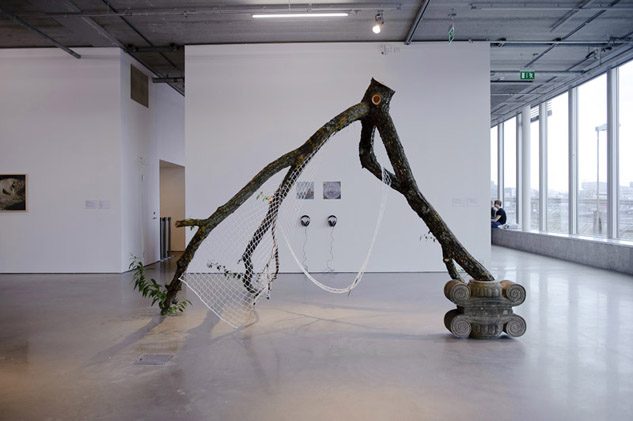
Cildo Meireles
In Casos de Sacos, paper bags – with their cubic measurements carefully printed on the front – hang in a line across the exhibition space. Each bag contains all the other bags, so that externally they have different shapes and sizes but the exact same weight.
In rio oir, one side of a vinyl record plays the sound of a river. The other side plays the sound of laughter. ‘Rio’ in Portuguese means both ‘river’ and ‘I laugh’, and when written forwards and backwards, these words create a palindrome – ‘rio oir’.
Cildo Meireles was born in Rio de Janeiro, where he lives and works. Over the course of four decades, he has been a key figure in the field of conceptual art.
During the military regime in Brazil, Meireles’ poetics were strongly critical of the regime and its censorship. In 1969 he was one of the founders of the Experimental Unit of the Museu de Arte Moderna in Rio de Janeiro, and in the 1970s worked as the editor for art magazine Malasartes. A retrospective of his work was presented at the New Museum of Contemporary Art, New York, USA, in 1999 and then travelled on to the Museum of Modern Art in Rio de Janeiro and the São Paulo Museum of Modern Art. Meireles was the first Brazilian artist to be given a full retrospective by Tate at Tate Modern, London, UK, in 2008. Following this, the exhibition travelled on to the Museu d’Art Contemporani in Barcelona, Spain, and later to the Museo Universitario Arte Contemporáneo (MUAC), Mexico City, Mexico.
João Modé
João Modé’s incense spirals in the piece Vanish have a short life cycle. Assembled in clusters, one spiral lights the next until only ashes remain.
João Modé was born in 1961 in Rio de Janeiro, where he lives and works. He participated in the 28th São Paulo Biennial (2008) and the Prague Biennial (2003). Some of his projects, such as REDE and Constelações, involve direct participation from the public. Overseas exhibitions include Connect – A Gentil Carioca, IFA Galerie, Berlin and Stuttgart, Germany (2010–2011); Brazilian Summer. Art & the City, Museum Het Domein, Sittard, Holland (2008); Stopover, Kunsthalle Fribourg, Switzerland (2006). João Modé was a founding member of the Visorama group which organized debates in the 1990s regarding issues dealing with contemporary art.
Fabio Morais
The title Uma linha, ou duas (2010) means ‘one line, or two’. A red line on the wall dissolves into an orange one, moving towards and joining the other works along the walls of the gallery. Carta a um jovem poeta (2004) is composed of cut-out letters from handwritten letters, postcards and notebooks, which have all been glued together in the exact word order from the first letter of Rainer Maria Rilke’s book Letters to a Young Poet. The pages have been written by 62 different hands over a period of 99 years.
Fabio Morais was born in 1975 in São Paulo, where he lives and works. Morais’ most recent solo exhibition was in 2010 at Galeria Vermelho in São Paulo. The same year, he participated in the 29th São Paulo Biennial.
Rivane Neuenschwander
Rivane Neuenschwander employs everyday materials and phenomena in works centred around themes such as travel, translation and transience. In First Love (2005/2011), viewers can describe their first love to a police artist who creates a facial composite, an image that has travelled a long way from the original object of love.
Gastronomic Translations (2005/2011) has its point of departure in a shopping list that the artist found in Frankfurt, Germany. She sent it to two chefs and invited them to prepare a banquet using nothing more than the ingredients on the list. On the opening day, Bonniers Konsthall’s visitors can taste the result:
Team Brasserie Le Rouge under the leadership of Marco Baudone and Fredrik Larsson
Poulet roti ‘Salsa vert’: Oven-baked free-range chicken, vinegar-grilled tomatoes, parmesan and salad cream
Cantaloup aux noix: Salsa of cantaloupe, tomatoes and roasted nuts
Team Kungsholmen Restaurant under the leadership of Magnus Persson
Grilled corn-fed chicken breast with oregano, parmesan cream and 90-degree tomatoes
Melon salsa
Salted, roasted pistachios
Gastronomic Translations is a collaboration with Spetsen Restaurant.
Rivane Neuenschwander was born in 1967 in Brazil, where she lives and works. Her most recent solo exhibitions include A Day Like Any Other, Mildred Lane Kemper Art Museum, Washington University, Saint Louis (2010) and New Museum, New York, USA (2010); Dominó Caníbal, PAC MURCIA, Spain (2010); Rivane Neuenschwander, Sala Verónicas, Murcia, Spain (2010); At a Certain Distance, Malmö Konsthall, Malmö, Sweden (2010). In 2011, her work will be shown at Untitled: the 12th Istanbul Biennial in Turkey and Our Magic Hour: How Much of the World Can We Know, the Yokohama Triennial in Japan.
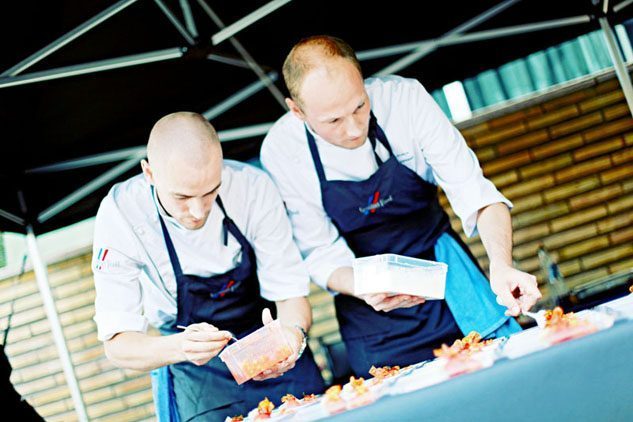
Natascha Sadr Haghighian
Natascha Sadr Haghighian modified a microscope so that instead of peering into it to gaze at something, we hear it play The Police song Every Breath You Take. The accompanying booklet contains a conversation between the artist and Philosopher of Science Evelyn Fox-Keller as they discuss how scientific instruments like the microscope have influenced our perception of reality.
In place of her biographical note, Natascha Sadr Haghighian wishes to draw readers’ attention to bioswop.net. At www.bioswop.net, artists and other cultural practitioners can borrow, exchange and compile CVs for various purposes. The site went online in October 2004 and is a work in progress. The aim is for more and more people to exchange their CVs for representational purposes like catalogues, etc. The project is aiming for even more ‘redundancy’ in that particular section of artists’ production. Bioswop hopes to finally undermine the purpose of art CVs and résumés – or at least make them a bit more of an entertaining read.
Rirkrit Tiravanija
Rirkrit Tiravanija’s Untitled 2011 (police police potato grease) is a silkscreen workshop located in the Konsthall entrance, where visitors can have a personal, unique T-shirt printed by one of our gallery hosts. The prints are in different languages – but something seems to have gone wrong in the translation.
Rirkrit Tiravanija was born in 1961 in Buenos Aires, Argentina. He lives and works in New York, USA, Berlin, Germany, and Bangkok, Thailand. Tiravanija was the winner of the 2010 Absolut Art Award and the 2005 Hugo Boss Prize awarded by the Guggenheim Museum. He recently held a retrospective exhibition at the Kunsthalle Bielefeld in Germany and the Museum Bojmans Van Beuningen in Rotterdam, Holland, the latter having travelled on to Paris and London. Tiravanija is also the president of an educational-ecological project known as The Land Foundation, located in Chiang Mai, Thailand.
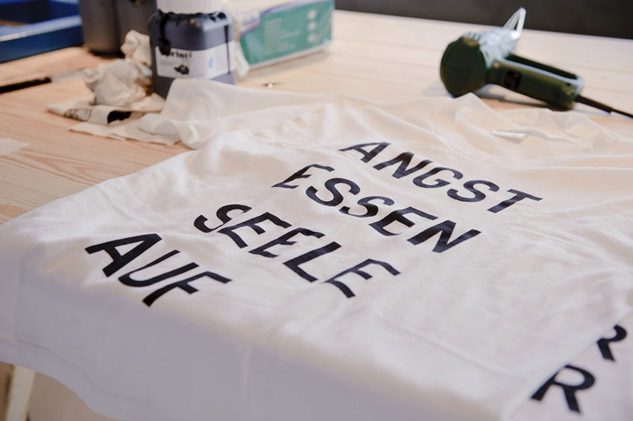
Haegye Yang
Three Kinds in Transition (2008) is a slide show containing 235 images. Objects of similar shape – footballs, globes, polyhedral origami objects – are dissolved and transformed into one another. Circular Flats (2010) is a work comprising three lighting sculptures; simple, white stands in metal covered in feathers, fabric, cables and other materials.
Haegue Yang was born in 1971 in Seoul, Korea, and lives and works in Berlin, Germany. Yang’s solo exhibitions include Teacher of Dance, Modern Art Oxford, Oxford, UK (2011); Arrivals, Kunsthaus Bregenz, Austria (2011); Voice and Wind, New Museum, New York, USA (2010); Voice Over Three, Artsonje Center, Seoul, Korea (2010); Integrity of the Insider, Walker Art Center, Minneapolis, USA (2009); 53rd Venice Biennial (2009); Siblings and Twins, Portikus, Frankfurt, Germany (2008).